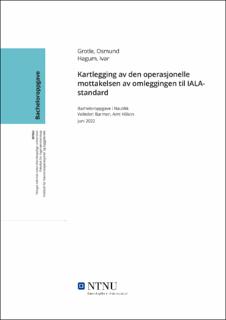| dc.contributor.advisor | Barmen, Arnt Håkon | |
| dc.contributor.author | Grotle, Osmund | |
| dc.contributor.author | Hagum, Ivar | |
| dc.date.accessioned | 2022-07-19T17:22:31Z | |
| dc.date.available | 2022-07-19T17:22:31Z | |
| dc.date.issued | 2022 | |
| dc.identifier | no.ntnu:inspera:114859670:114862803 | |
| dc.identifier.uri | https://hdl.handle.net/11250/3007032 | |
| dc.description.abstract | I 2019 startet kystverket omleggingen av landets 1900 fyrlykter til IALA standard. Der endringen skjer i samsvar med nødvendige og planlagte vedlikeholdsoppdrag. Dette er en standard for hvordan sektorene til en fyrlykt skal være, og vil føre til endringer langs hele kysten. Grønne og røde sektorer vil bli omorganisert, og nye sektorer vil bli satt inn for å tilfredsstille kravene til IALA. Parallelt med omleggingen utføres det også en teknologisk oppdatering av lyktene. Der gamle halogenpærer vil bli byttet ut med LED, og strømledninger vil bli fjernet til fordel for solcelle og batteri. Vi ønsker i denne sammenheng å se nærmere på den operasjonelle mottakelsen av omleggingen til IALA-standard og de innvirkende omstendighetene rundt dette.
Vi vil først ta for oss prosessen bak og under omleggingen. Hvordan merkesystemet brukes, og hvordan endringene vil påvirke måten de kommer til å bli brukt. Vi ser nærmere på informasjonsflyten underveis i omlegningen, og hvordan det informeres at lyktene er skjermet om for å imøtekomme den nye standarden. Ved hjelp av kvalitative intervju av tre navigatører, to loser, og en ansatt i kystverket med ansvar for omleggingen, har vi fått en god forståelse for hvordan det nye systemet har blitt mottatt og hva som kan være fordeler og ulemper. Ulike funn fra intervjuene blir lagt frem i et eget kapittel før vi drøfter disse for å veie ut de ulike aspektene.
Omleggingen har blitt mottatt med optimisme blant navigatører, mens losene ikke ser like lyst på saken. Endringene virker til å være rettet mot både sivile og profesjonelle som går langs norskekysten, men at det ikke nødvendigvis gagner den grupper som bruker systemet mest. Informasjon vi fikk av losene vi intervjuet ser ut til å støtte denne påstanden. De teknologiske endringene har gjort lyktene mer pålitelige og gir et stabilt og trygt navigasjonshjelpemiddel langs kysten. | |
| dc.description.abstract | In 2019, the Norwegian Coastal Administration started the conversion of the country's 1900 lighthouses to IALA standard. Where the change takes place in accordance with necessary and planned maintenance assignments. This is a standard for how the sectors of a lighthouse should be. This will lead to changes along the entire coast. Green and red sectors will be reorganized, and new sectors will be deployed to meet the requirements of IALA. In parallel with the conversion, a technological update of the lights is also carried out. Where old halogen bulbs will be replaced with LEDs, and power cords will be removed in favour of solar cell and battery. In this context, we would like to take a closer look at the operational reception of the change to the IALA standard and the influential circumstances surrounding this.
We will first consider the process behind and during the reorganization. How the marking system is used, and how the changes will affect the way they will be used. We take a closer look at the flow of information during the reorganization, and how it is informed that the lights have been shielded to meet the new standard. With the help of qualitative interviews of three navigators, two pilots, and an employee of the Coastal Administration with responsibility for the reorganization, we have gained a good understanding of how the new system has been received and what may be the advantages and disadvantages. Various findings from the interviews are presented in a separate chapter before we discuss these to weigh out the various aspects.
The reorganization has been received with optimism among navigators, while the pilots do not see the matter as brightly. The changes seem to be aimed at both civilians and professionals who navigate along the Norwegian coast, but that it does not necessarily benefit the groups that use the system the most. Information we received from the pilots we interviewed seems to support this claim. The technological changes have made the lanterns more reliable and provide a stable and safe navigation aid along the coast. | |
| dc.language | nob | |
| dc.publisher | NTNU | |
| dc.title | Kartlegging av den operasjonelle mottakelsen av omleggingen til IALA-standard | |
| dc.type | Bachelor thesis | |
